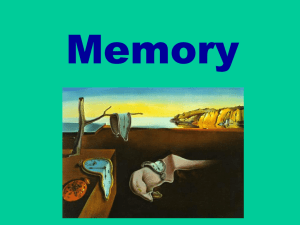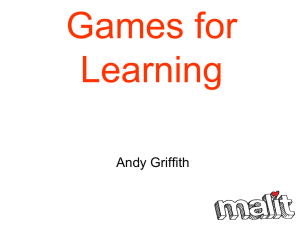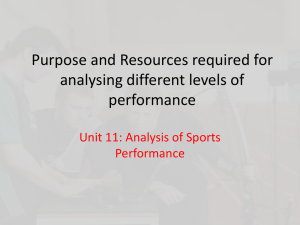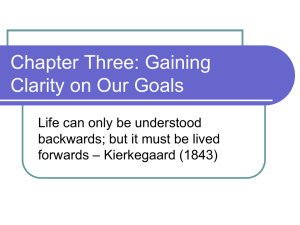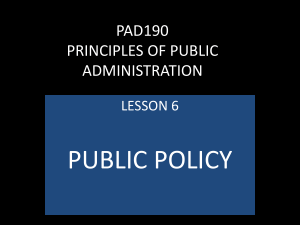Effect of acute physical activity on cognitive functions: molecular
advertisement
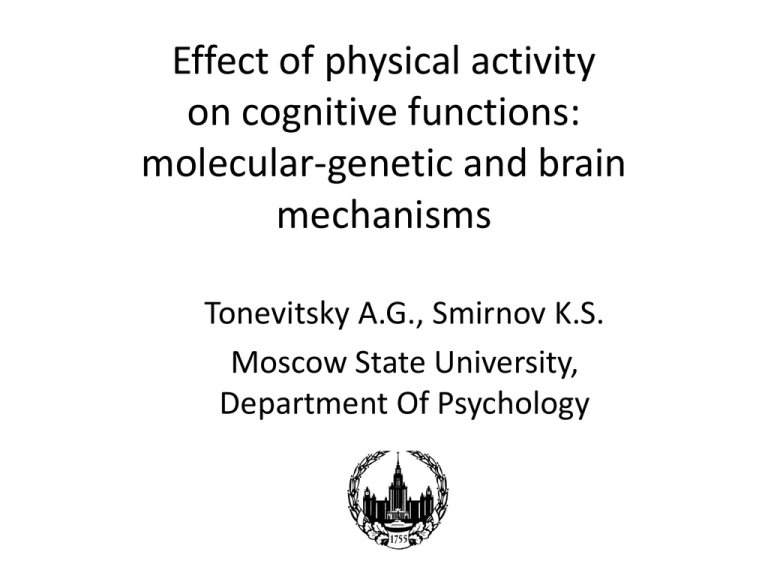
Effect of physical activity on cognitive functions: molecular-genetic and brain mechanisms Tonevitsky A.G., Smirnov K.S. Moscow State University, Department Of Psychology Main Topics • How does physical activity affect on cognitive functions? • What molecular-genetic and brain mechanisms underlie these changes? Time Perception • Internal representation of temporal durations • Reflects cyclic nature of external and internal processes • Associated with physiological parameters such as heart and respiratory rate etc. • Connects with psychological and social characteristics (types of CNS; temperament; impulsivity; ethnical background) • Dopamine and serotonin systems are reported to be connected with time perception Molecular genetic model of 5HT activity MAOA (5-HT degradation) MAOA VNTR 5-HTT (re-uptake of the 5HT) 5-HTTLPR 5-HT2a receptor 5-HT2a T102C Higher 5-HT activity = less (MAOA and 5-HTT) and more 5-HT2a receptor Molecular genetic model of DA activity COMT (DA degradation) COMT V158M DAT (re-uptake of the DAT) DAT VNTR DRD2 receptor DRD2 TaqI A Higher DA activity = less (COMT and DAT) and more DRD2 receptor Findings on genetic basic of time perception • Carriers of genotypes related to the increased level of 5-HT transmission are characterized more pronounced “subjective shortening” of elapsed time intervals and less accurate orienting in time • Carriers of less active variant of COMT tend to overestimate short (1-2 sec) durations in duration reproduction task and underestimate long durations in orienting in time Methods • • • • • • • Subjective second Maximal tapping Comfort tapping Attention Network Test EEG Heart rate Scaled self-report (health, mood, activity) Participants • Elite athletes: o Olympic biathlon team (11 males, 4 females) o Olympic cross skiing team (19 males, 10 females) • Nonprofessional athletes: o University wrestling team (15 males) • Controls: o healthy students not involved in regular sport activity (15 males, 10 females) Results subjective second 1600 1400 1200 subjective second variability (std) * * * 300 250 * 1000 200 800 BL 600 AP BL 150 AP 100 400 200 50 0 0 Wrestlers Biathletes Wrestlers Biathletes maximal taping 250 self report (wrestlers) * 5.6 * 5.4 200 5.2 150 100 BL 5 AP 4.8 BL AP 4.6 50 4.4 0 Wrestlers Biathletes 4.2 Health Activity Mood Conclusions •Significant decrease of subjective second and maximal tapping time after physical load • Significant difference between elite and intermediate level athletes • Increase level of activity Attention According to the theory of attention networks, there are three basic systems: • alerting or vigilance system • orienting system or system of selectivity • executive or conflict system Executive attention - anterior cingulate and prefrontal cortex - dopamine Alerting attention - subcortical brain structures - norepinephrine Orienting attention - structures of the visual cortex - acetylcholine Attention Network Test designed to investigate all three systems by combining different types of cueing and target stimuli No alerting effect of cue for elite biathletes alerting attention f or congruent stimulus Current ef f ect: F(2, 61)=3,4165 p=,03923 70 60 50 ms 40 30 20 10 0 biathlon ski control Smaller orienting effect of cue for elite biathletes oriention attention f or congruent stimulus Current ef f ect: F(2, 61)=6,4247 p=,00294 120 110 100 90 80 ms 70 60 50 40 30 20 10 0 biathlon ski control Though biathletes scores for orienting are smallest they achieve relatively biggest profit for incongruent stimuli Wilks lambda=,82197, F(4, 120)=3,0898 p=,01842 120 110 100 90 80 70 60 50 40 30 biathlon ski sport control conguent incongruent Contingent negative variation (CNV) for no cue condition response N1 component, latency effect Elite athletes central cue no cue * Controls central cue no cue Topography of ERP to the target N1 (200 ms post-target) Controls Alerting = no cue + center cue Elite athletes Conclusions • Elite athletes has lower alerting and orienting scores • Low alerting and orienting scores in elite athletes is due to increased “readiness” in the no cue condition, revealed by higher CNV • Elite athletes has higher and earlier N1 component even in no cue condition • Demands of sport discipline also effect on efficiency of alerting system Thanks to • Sysoeva Olga • Polikanova Irina
